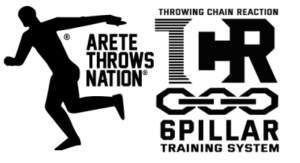Today, I’m gonna do a comparison between the language and structure of teaching the TCR™ system vs Data language.
* BTW, If you are not using the TCR™ system, you better be using the Data Language system… or you’re just stabbing in the dark!
The uber studs that have Ph.D’s in physics break down the throw as follows:
Back swing, first double support, first single support phase, flight phase, second single support phase, second double support phase (or power position) and delivery phase.
Run that by your youth or high schoolers, and then take a picture of the look on their faces!
The science experts do make perfect sense, and it’s also pretty clear when you think about it, but it is a mouthful. They talk about power and mechanical positions and the data at each phase and a lot of awesome detail…
… but these guys are trying to provide data to experienced full time coaches; many of whom are elite level coaches (typically).
I am nothing short of a super fan of all their research and data. I have nothing but respect and appreciation of what they provide as I consider myself a high level coach and it has helped me solidify a better understanding of the throw and made me a better coach…
… but, in my experience, this type of language isn’t for youth or high school level athletes… or for most of the thousands of seasonal throws coaches.
Plus, many of those Ph.D’s will tell you they can analyze the throws, but the wouldn’t necessarily be able to coach it.
The Throwing Chain Reaction™ is a system that is meant to help simplify data and complexity. It helps provide an understanding of how to implement the technique while teaching it.
The Ph.Ds will say, ” Here is the data, we hope that is helpful, go use what will help you most.”
Back in the day, my thing was that I wasn’t a the super freak with talent. I was the talented guy with a lot of potential. I only threw 172’3 in high school. I squeaked out All-American status, and became top 10 in the US 3 years out of college….
… How? I studied… A lot!
I know many super freaks, and have coached a few, but statistically the super freaks are less than .1% of everyone who throws.
Meaning 99.9% are not the super freak.
Jordan Geist is a super freak.
So, I figure I was somewhere in the 90+ percentile. Pretty damn good, but not good enough to throw in the PAC 10 out of high school… yes it was the PAC 10 back then.
Point is, I began to understand the importance of each phase of the throw, the goals of each phase, and where my weak points where in the throw and what was causing my weaknesses….. The super freaks just do it.
… and when the super freaks are well coached, they become the best in the world.
Most coaches will see the majority of average kids. So what is gonna work for you?
The TCR™ is a system designed to take young throwers, and showing them how to train right, move right, understand and apply using simple language.
The TCR™ language allows for better technical understanding, and a way to maximize young throwers …
… not ot mention it greatly helps coaches that are working with the statistical majority to produce better throwers.
Believe me, I have had some throwers with a lot of success that wouldn’t have achieved much without the TCR™ system leading the way…. it wasn’t easy, but the TCR™ structure made their success possible.
So, let’s review the TCR™ language of the 6 pillars of the rotational throws.
Pillar 1- Set the trigger action.
If you don’t set up the throw correctly, you wont be able to execute and enter the throw on balance or efficiently. The start, or wind up, is often not coached and a ton of detailed stuff is happening in the wind up that produces consistency… or a lot of inconsistency.
Pillar 2- Set up maximum power
This is critical to maximizing your throw, and prepping for a dynamic and fast entry into the ring in order to create the most speed into the middle. Flexibility and strength are critical to optimizing this phase of the throw.
Pillar 3 Drop in and Apply Max Speed
This is all about learning how to enter the middle and create powerful lower body speed and a dynamic sweep leg
Pillar 4- Axis transition-
moving from one single support to the second, the transition from the left to the right (or the opposite for lefties), and where you set up the maximum amount of separation and torque.
Pillar 5- Lock down power–
how to move from the power position to delivery. Generating maximum power in a very short period of time is crucial.
Pillar 6- Delivery- Fishing Big.
The block, the path of the block arm, the drive leg to create the greatest transfer of momentum. One of the most complicated sequences in the throw.
It’s a pretty freak in’ good system…if I do say so myself!
The TCR™ system was purposefully designed to take the complexity of scientific concepts in physics and translating them into ease step-by-step pillars to follow…
… making it easier to coach, easier to comprehend as a thrower, and this equals faster and bigger results…. Just blinding you with science!
We here at ATN have used the TCR™ system to produce 81 championship titles, Olympic trial finalists, and youth national champions.
Our TCR™ online member coaches have produce champions at all levels… even youth world records!
Work your pillars, get results fast!
Throw far,
Coach Johnson



